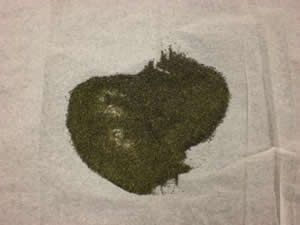Olivine Separation
Normally, olivine separation is not done. However, olivine can be rapidly separated from rocks such as basalt using a variant on the froth flotation method known as grease tabling. Grease tabling is commonly used in the diamond mining industry because diamonds are naturally hydrophobic.

Magnetically separate the sample using an electro magnet or a hand magnet and funnel. Next use the Carpco magnetic separator once at each magnet coil current 1, 2, 3, and 4.
Soak the non-magnetic fraction in frothing solution. Frothing solution: 1g/L lauryl amine, 1ml/L glacial acetic acid, 1L water. This makes olivine and other silicates hydrophobic, so they will stick to grease. Pour solution and sample over a baking dish covered in petroleum jelly. Silicates stick to petroleum jelly and all other minerals wash off with water in squeeze bottle.
Scrape off olivine and petroleum jelly and place in beaker with solution of dish soap and hot water. Use ultra sonic tank to speed the dissolution process. Rinse well.
Fill 250ml separatory funnel with 125ml lithium metatungstate (LST) at density >3.0. Density greater than 3 can be achieved by adding small amounts of tungsten carbide powder to the LST. Wait several minutes and quickly drain the olivine from the separatory funnel by rotating the stopcock 90 degrees for a few seconds then another 90 degrees. Rinse well.
